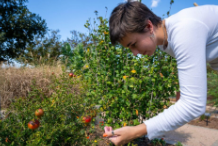Deadheading is the process of removing spent flowers from a plant. Multiple benefits can be achieved from this task. It promotes blooming and can lengthen the bloom season. Plants naturally direct energy toward seed production. By removing old flowers from the plant, seed production is halted and the plant will use energy to create additional blooms.
Some plants do not benefit from deadheading. Impatiens, moss rose (Portulaca) and fibrous begonias are known as “self-cleaning” and do not need to be deadheaded to remove spent blooms. Melampodium is a quick-growing annual and will grow past expired blooms so deadheading isn’t necessary. Most flowering vines, periwinkle (Catharanthus) and wishbone flower (Torenia) also do not require deadheading.
There are some other reasons you may choose not to deadhead. Removing flowers prevents the plants from reseeding consequently limiting the number of plants the following growing season. No seedheads also eliminates a food source for birds and other wildlife. Some plants such as coneflower (Echinacea) have attractive seedheads you may choose to leave intact.
Hardy geraniums, coreopsis, petunias, marigolds (Tagetes), snapdragons (Antirrhinum), begonias, roses, campanulas, blanket flowers (Gaillardia), delphiniums, zinnias, sweet peas (Lathyrus odoratus), salvia, scabiosa, annual heliotrope, geraniums (Pelargonium) and yarrow (Achillea) are all plants that increase flower production if deadheaded.
Blooms should be removed as soon as they begin to fade. For soft-tissue plants, the bloom can usually be pinched off using your thumb and forefinger. Pruners may be required for tougher stems.
Extension Agent, Cynthia Domenghini




